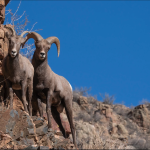Summit Outside: The elusive pine marten
Special to the Daily

ALL |
This past week I saw a pine marten while skiing at Breckenridge Nordic Center. I caught a glimpse of a brown-colored critter darting around the woods at the edge of the Gold Digger trail. When I got a better look, I could see a long, slender animal with a long tail and long neck. When he turned and looked at me I saw a small cute face with a pointed nose. He had a light blond patch of fur almost like a bib. His long, narrow body was about a foot or more long with a tail nearly the same length as his body.
The pine marten climbed part way up and down a tree, scurried around the bushes and then darted across the trail right in front of me, darted around and then took off into the woods. I motioned to a father and young son skiing up to stop and they were lucky enough to see the marten too. The father said it was his first marten sighting.
Pine martens belong to the weasel family but are larger than weasels, do not have the webbed toes of the mink and are smaller than the fisher. The scientific name is “Martes americana” and they are found primarily in mature, northern forests.
These animals are closely associated with lodgepole pine, Douglas fir, spruce and mixed hardwood forests. They tend to be found in structurally complex, mature forests, and can occur at all elevations where such habitat exists.
The pine marten is mostly nocturnal, but this little fellow was running around in broad daylight. It was about 11 a.m. This confirms the fact that many animals in winter change their behavior.
There is a healthy population of squirrels and mice in the surrounding pine forest and I suspect he was probably hoping for one to cross his path and provide lunch. On a cold winter night this little fellow probably is burrowed into the snow for insulation from the cold. When snow cover is light and nights are cold it must be hard on solitary animals to keep warm.
The best way to know whether pine martens are around is to find their tracks in the snow. Winter is a wonderful time for finding tracks and identifying animals that are up and about. Tracks are especially distinct right after the Nordic trails are groomed.
The pine marten has five toes in a 1-3-1 grouping. The little toe on the inside of the foot sometimes does not register. The interdigital pad is chevron-shaped (somewhat v-shaped). A proximal or rear pad can sometimes be seen in the front paw print. The rear paw print is elongated and furry so the so the pads may not be seen. Claw marks can sometimes be seen as the claws are long, sharp and curved.
The front paw prints are about 2 inches while the rear paw prints will be slightly larger. When they run or gallop you will see sets of prints spaced in a two-by-two or a four-by-four pattern about 22 inches apart. Look for tracks around tree trunks.
Sometimes there are scratch marks where their stomach drags over objects that protrude from the ground. You might see a place where they disappear beneath the snow.
Scat is another good way of identifying different animals. The pine marten scat will often contain hair, nuts and berries, and appears like a long slender cord that folds back on itself and is tapered at both ends. The total length might be about 2 by one-quarter inches.
In the winter, pine martens may travel extensively under the snowpack in subnivean tunnels. Subnivean travel routes of more than 98 feet have been measured and documented. Marten are well adapted to snow. Individuals can navigate through deep snow regardless of depth, with tracks rarely sinking more than 2 inches into the snowpack.
Where deep snow accumulates, pine martens prefer locations that prevent snow from packing hard and have structures near the ground that provide access to subnivean sites. Martens tend to reduce activity during colder days, and they need to hunt bigger prey and choose well insulated resting sites, either at or below ground level. They have very powerful jaws and can capture prey the same size or bigger. They are very agile and can jump from tree to tree.
High mortality may occur if the pine marten become wet in cold weather, as when unusual winter rains occur.
Pine martens are primarily solitary and elusive so you will not see a group of them together. Adult males and females have however been seen together with immature animals, presumably their offspring.
You might occasional hear a marten. They communicate by using vocalizations which sound like huffs, chuckles and screams.
Some predators of the pine marten are: the great horned owl, bald eagle, golden eagle, lynx, mountain lion and black bear. Most predation occurs in May and August, and little or no predation occurs between December and February.
The other predators of the pine marten were humans. Pine marten were hunted and trapped for their fur by colonists until their populations declined drastically. I could not find any recent studies on pine marten populations in Colorado. One study from the 1950s indicated a population increase. Another study from the 1970s had overall population densities, including animals of both sexes and all ages, probably not in excess of five animals per square mile.
Breckenridge resident Dr. Joanne Stolen is retired from teaching microbiology at Rutgers University.

Support Local Journalism

Support Local Journalism
As a Summit Daily News reader, you make our work possible.
Summit Daily is embarking on a multiyear project to digitize its archives going back to 1989 and make them available to the public in partnership with the Colorado Historic Newspapers Collection. The full project is expected to cost about $165,000. All donations made in 2023 will go directly toward this project.
Every contribution, no matter the size, will make a difference.









